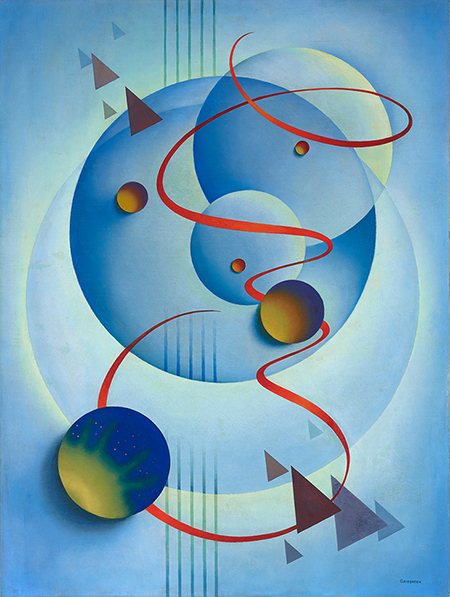
Continuing through June 19, 2023
Organized by independent curator Michael Duncan and the Crocker Art Museum in Sacramento, this elegant and scholarly exhibition tells the story of eleven under-recognized modern artists who were bonded by a shared faith in painting’s potential to evoke synesthetic experiences and heightened spiritual consciousness. Co-founded in 1938 by New Mexico-based painters Emil Bisttram and Raymond Jonson, the Transcendental Painting Group (TPG) shared the ideals of Wassily Kandinsky, Piet Mondrian, Kazimir Malevich, and Hilma af Klint, European pioneers of non-objective painting who embraced occult spiritual systems such as Theosophy. Like these predecessors, the TPG even had a manifesto. Its stated goal was “to carry painting beyond the appearance of the physical world, through new concepts of space, color, light, and design to imaginative realms that are idealistic and spiritual.”
Bisttram painted while meditating on creation. He subscribed to the Theosophical concept that the key to connecting materiality to spirituality is to be found in mathematics and, accordingly, he structured his compositions using a system of Euclidean geometry known as “dynamic symmetry.” As a result, several of his paintings with references to planets and zodiac symbols resemble scientific charts, only they are supercharged by vibrant color progressions and a shimmering luminosity that reflects the open spaces and “almost mystic quality of light” in Taos, where Bisttram founded the Taos School of Art.
Jonson, a professor at the University of New Mexico in Albuquerque, also relied heavily upon geometric structuring. His compositions, however, are more stylistically diverse than Bisttram’s, with several here reminiscent of landscapes by Arthur Dove. Most of Jonson’s paintings tend to be blander and more static than Bisttram’s, yet he does achieve a comparable level of visual vibration — perhaps the primary measure of a successfully transcendent image. In Jonson’s non-objective “Oil No. 9” (1942) a red totem composed of stacked biomorphic shapes is illuminated by a white aura and effectively played off against a backdrop of shifting, colorful, transparent geometric planes. When he designated this type of work “absolute painting,” Jonson echoed the earlier voices of Malevich and Mondrian.
Jonson and Bisttram championed their ideas in the classroom. Six of the artists in “Another World” were among their students. While we might expect their disciples to produce dogmatic variations of their instructors’ imagery, it is refreshing to see that each of the mentees managed to maintain a distinctly independent voice.
Jonson’s students included Ed Garman, William Thomas Lumpkins, and Stuart Walker. As a means of supporting his studies, Garman went on archeological digs and inventoried pottery shards. Inspired by the geometric designs of indigenous ceramics, his “Painting No. 231” (1941) dynamically anticipates the Pattern and Decoration movement paintings of the 1970s. Attracted to Zen Buddhism, Lumpkins was fascinated by the fluid movements of watercolor and from that evolved his practice of Surrealist automatism. Walker’s geometric abstractions come closest to Jonson’s concept of “absolute painting,” yet they are more lyrical, an aspect that the exhibition curators attribute to the influence of Agnes Pelton, a long-distance participant in the group.
The youngest member of the TPG, Florence Miller Pierce, studied under Bisttram, along with her future husband Horace Towner Pierce and Robert Gribbroek. Later in life, Miller Pierce would become a prominent practitioner of Minimalist painting, and the seeds of this are evident in the exquisite “Rising Red” (1942), a light and airy composition that pulls us in via the simple interactions of two ellipses and a circle. Had he not died at an early age, Horace Pierce would likely have made his mark as an experimental filmmaker, having adapted the principle of “dynamic symmetry” to a series of non-objective watercolors that were conceived as individual frames of an intended animation. Realized posthumously in 2020, his 8-minute “The Spiral Symphony in Four Movements: Birth, the Crystal, the Flower Death” can be seen as a wall-projected video playing directly above a selection of the watercolors. Gribbroek, who produced the quirkiest work on view here, actually found an eventual home in the field of animation, working on cartoons for Disney and Warner Bros. studios. The swirling movements of ribbon-like forms spiraling through overlapping orbs in his “Composition #57/Pattern 29” (1938) indeed suggest the start of a movie title sequence, while Gribbroek’s paintings of desert plant life possess the whimsy, color, and vibrancy of animated cartoons.
Jonson’s circle of artists extended beyond the university milieu, and two of his friends were instrumental in the formation of the TPG. One of them, the Canadian artist Lawren Harris maintained a strong interest in Theosophy, and was in Santa Fe from 1938-40. Harris’ abstract paintings, which feel remarkably contemporary, are distinguished by brilliant light and a towering verticality. Dane Rudhyar, a composer as well as a painter, is represented by lush abstract watercolors. Though not an official member of the Transcendental Painting Group, he was the group’s chief proselytizer. More importantly, Rudhyar convinced Jonson to bring the work of Southern California-based Agnes Pelton to Santa Fe in 1933, where her exhibition had an enormous impact on the New Mexico artists.
Pelton, who chose to live and work in the then-remote Coachella Valley town aptly named Cathedral City, maintained a TPG association from her home base. Working in relative isolation so she could freely commune with nature, Pelton produced spectacular visionary images that resemble desert mirages, some of which are accompanied by self-penned poems. A believer in Theosophy who humanized the theoretical ideas underlying her paintings through poetic references to the material world, Pelton outshines all the others with her opulent depictions of imaginative forms that suggest giant eggs glowing from within, fountains and flowers rising from the earth, and a boat’s sail reaching towards the sun.
